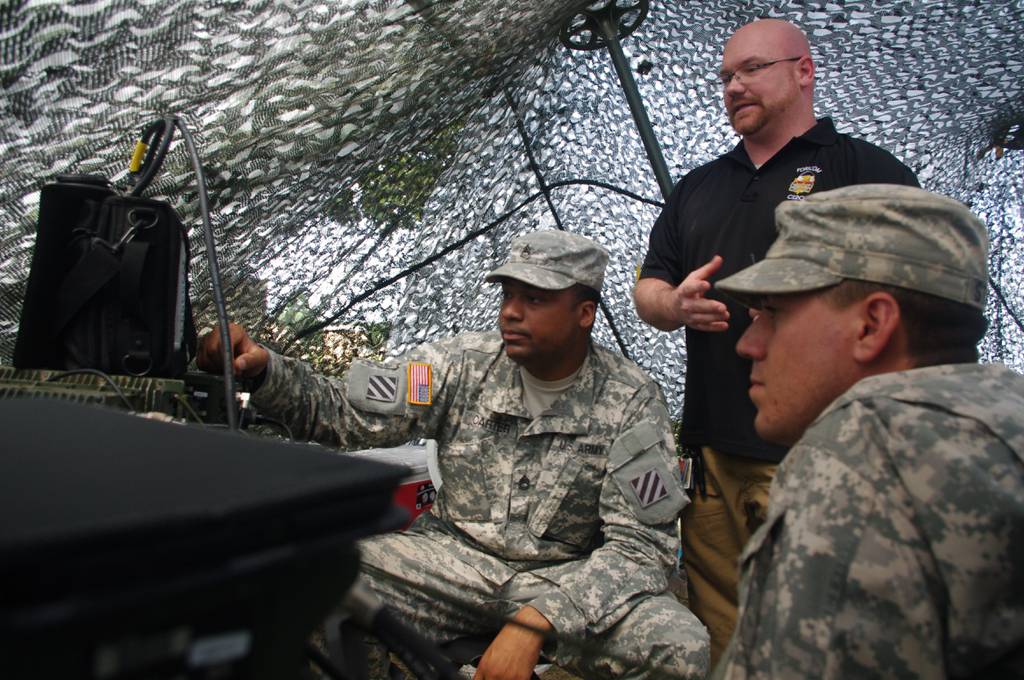In electronic warfare, interoperability is critical to prevent friendly jamming and confusion on the battlefield.
While interoperability is limited for now, only existing at shared databases, the Army and Marine Corps are focused on improving their capabilities and sharing abilities.
Interoperability has traditionally been an agenda item from the last three Army-Marine Corps boards, where the Army chief of staff and commandant of the Marine Corps discuss commonalities and where they can trade these off, said Col. Mark Dotson, Training and Doctrine Command Capabilities Manager - Electronic Warfare at Cyber Center of Excellence and Fort Gordon.
Dotson, speaking to C4ISRNET at TechNet Augusta on Aug. 9, added that there is an Army and Marine Corps synergy meeting quarterly where they — counterparts in the signals intelligence and electronic warfare communities — discuss how they can work together in processes and equipment.
Right now, with the commonality and interoperability only existing at the database level, if Marines pick up a signal and put it into the database, the Army can see it. Moreover, the Army has the ability to display Marine Corps systems capabilities as a display in Army systems.
The Army is still building out its primary planning tool for electronic warfare called Electronic Warfare Planning and Management Tool (EWPMT), which will allow commanders to plan and understand the electromagnetic spectrum environment through visual graphical user interfaces.
[ Planning for electronic warfare: Army looks for latest tech ]
Dotson said if a Marine was in an Army headquarters and pulls up EWPMT, given they were in the Army headquarters they would be able to see the graphical user interface as they normally would from their equipment.
Still, however, the two services through their synergy meetings are working on controllability of EWPMT and Marine systems to be able to talk to each other.
In September, Dotson told C4ISRNET, there is going to be a table top exercise at Quantico, Virginia, where they’ll go through the process with the Marines, gaming out how they’ll work and interoperate with equipment. Following that effort, in February they will have an exercise at Fort Huachuca, Arizona, in which the Marines will use Army equipment and have soldiers training with them, testing what came out of the table top exercise in September.
Dotson also indicated the Army is interested in the EW system the Marines are currently using, acknowledging that the Marines are ahead of the Army in the equipment space, But he also offered there is not a significant difference between requirements within each service.
Coalition interoperability
When it comes to interoperability with coalition partners, Dotson said while this is not specifically written into Army requirements, it is a consideration for program managers who also are responsible for producing what the Army Rapid Capabilities Office delivers to combatant commands and theaters needing the capability. The RCO is currently focusing on delivering an EW solution to Europe to get at critical capability gaps that exist there relative to the threat.
“If our doctrine evolved and [partners’] did not, most likely in a high-end fight we would chose to not use many of our high-end capabilities because it would interfere too much with their capabilities,” William Conley, deputy director of EW within the Pentagon’s office of acquisition, technology and logistics, said in June, highlighting a key interoperability problem.
[ US may forgo using EW capabilities if coalition tech isn’t compatible ]
Conley acknowledged that over the last decade, NATO has substantially revolutionized its doctrine in this space. But given that the U.S. rarely fights alone, its capabilities have to be compatible or at least shareable with allies in some way, “such that they don’t turn around and go ‘what’s that,’ assume it was an adversary system … and turn around and begin trying to deny us.”
Referencing what the outgoing commander of Army Europe, Lt. Gen. Ben Hodges, has said, Dotson noted Hodges expressed he doesn’t want anything he can’t work in with coalition partners.
As the Army works on its emerging EW capabilities, which are being built on American requirements, Dotson said they have to figure out what they can, and how to, share with coalition partners.
Mark Pomerleau is a reporter for C4ISRNET, covering information warfare and cyberspace.








